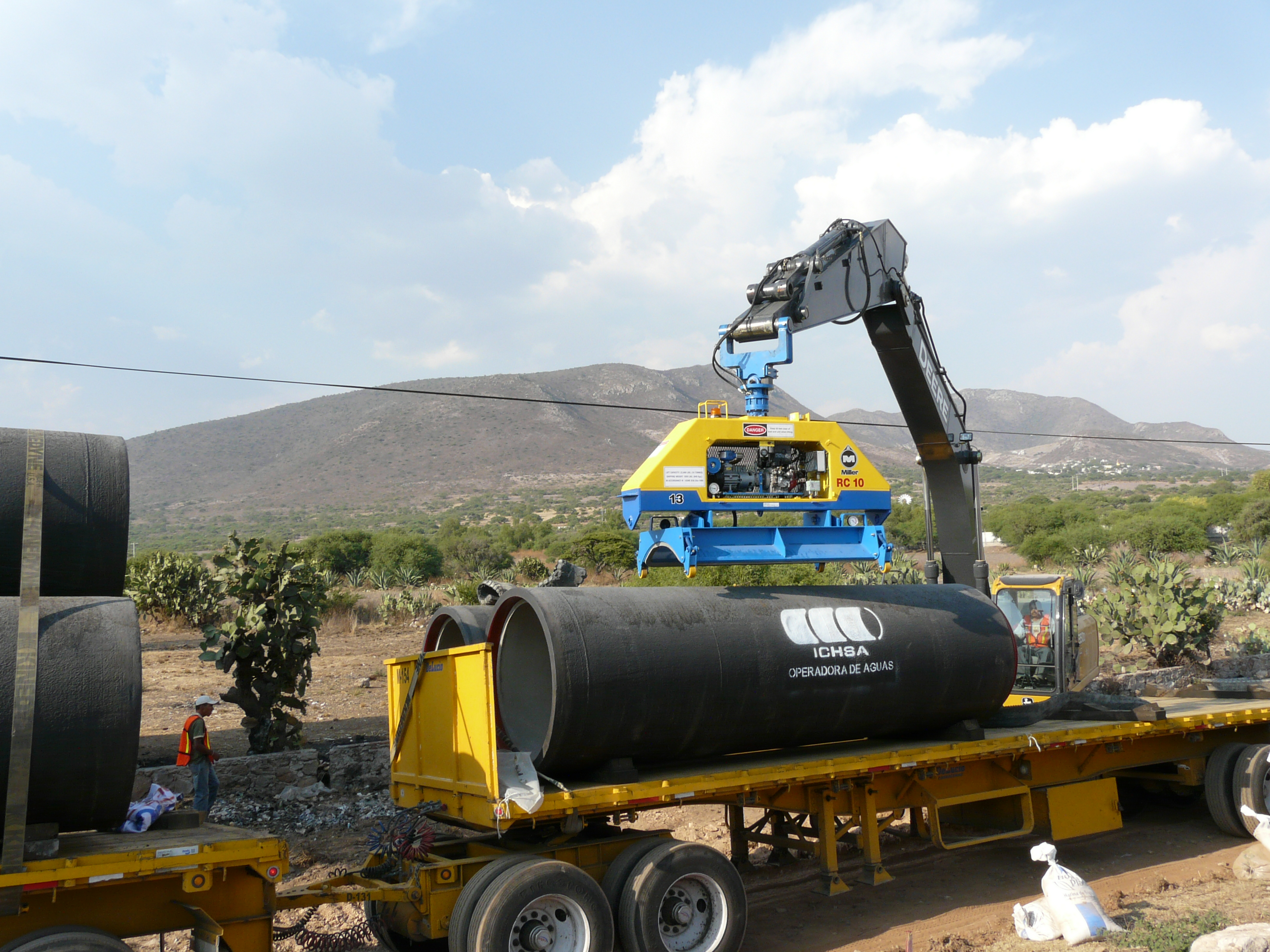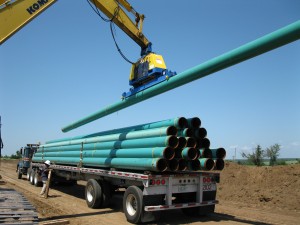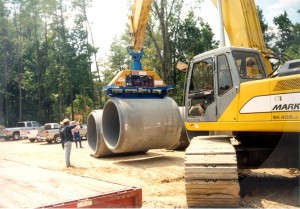August 2010 Vol. 65 No. 8
Features
Vacuum Lifters Diversify Into Multiple Material Applications

Handling pipe on construction jobs is a labor intensive, time-consuming and potentially-dangerous task, but one that is necessary on every water, sanitary sewer and energy pipeline project, as well as many utility projects where cable is placed in duct or conduit.
Pipe supplies must be unloaded from trucks and each length or reel of pipe moved into position for placement in the ground. The conventional method for accomplishing that is to strap or chain pipe to an excavator boom or crane to move joints of pipe.
Using a powerful vacuum force, a vacuum lifter can unload and position most types of pipe used on underground utility construction projects. Vacuum suction securely holds material, eliminating the need to strap or chain pipe to the lifting boom, preventing material or coating damage that can be caused by other lifting methods.

Vacuum lifting equipment has been routinely used on pipeline projects for more than a decade, and Vacuworx, a primary supplier of vacuum lifters, introduced the MC “mini” model at the 2009 UCT show in San Antonio.
Sales of the MC “mini” have been well over initial projections, said Shawn Lowman, Vacuworx director of sales and marketing.
“Contractors have welcomed the mini, especially on the distribution side of the industry,” Lowman said. “The staple for the mini has been steel pipe up to 12 inches OD in 40-foot lengths and smaller.”
Components
MC lifting unit components include the main beam and reservoir; small displacement, one-cylinder gasoline engine vacuum pump, vacuum valve; hydraulic reservoir and system; rotator; and vacuum pad. It can be mounted on an excavator, backhoe, wheel loader, forklift, boom truck, or other types of equipment routinely used on construction sites. For example, it can be pinned to an excavator; has fork pockets for forklifts and loaders; and is available with a picking eye for a crane or knuckle boom type truck. The vacuum unit is controlled from the host vehicle with a closed-frequency wireless remote.
Host equipment must have the capacity to accommodate the approximately 800 pounds of the lifter, plus the weight of the load.
Vacuworx manufactures five vacuum lifting units ranging from the MC which can lift 6,600 pounds to the RC20 with lifting capacity of 44.000 pounds.
“All of our lifters apply to a utility project but due to the weights of materials being lifted the mini is certainly the best fit,” Lowman said. “Most utility contractors do not need our larger models very often.”
The benefits of vacuum lifting extend beyond moving steel pipe, and Lowman said contractors in the utility and general construction industries are discovering that a growing number of applications are suited to the procedure.

“Using vacuum lifters for concrete pipe has taken off recently,” said Lowman. “Minis are being used on a lot of concrete culvert work in ODs as large as 30 inches. Because concrete culvert pipes are short and weigh less than longer joints of steel pipe, we haven’t found a limit on OD size the mini can handle.”
Lowman said MCs also are being used for concrete drop boxes and lids for drainage work. As weights increase, the larger RC10 models (22,000 pounds lifting capacity) may be put in service.
New market
The most prominent “new” market for vacuum lifters, said Lowman, is for plate steel.
“The mini,” he continued, “has proven very effective for moving the road plate that contractors use to cover holes they have excavated for making repairs so that cars can drive over the affected areas. They unload plates off trucks with a mini attached to the end of job-type crane and position the plate over the excavation. The process is reversed when removing the plates. It is preventing a lot of delays and saving smashed fingers.”
Large custom plate lifters are being used in rail yards and ports for unloading and loading rail cars and barges.
“The Vacuworx plate system,” Lowman said, “will typically replace what was once being done with two forklifts or wheel loaders and their operators, doing the job faster with one machine and operator. Unlike magnets on a crane, the Vacuworx system requires no cool down time.”
Whatever the lifting job, Lowman believes vacuum equipment is superior to conventional methods.
“Any contractor utilizing vacuum lifting versus traditional methods can expect numerous benefits,” Lowman said. “We certainly focus on the safety aspect of the Vacuworx system but the efficiency benefits are hard to ignore. Contractors can increase load and unload cycles by 700 to 1,200 percent, and do so with less people. That is a huge cost savings, not to mention payroll savings for less people needed. Some contractors have reported that they have received a reduction in insurance rates due to having no one in harm’s way when lifting.”
When installing concrete, PVC and ductile iron pipe, Lowman said a vacuum lifting system can be used to slip joints of pipe together in the trench, an important safety feature.
Several companies currently offer vacuum lifting equipment. Lowman said Vacuworx sets itself apart from others by being the only company that specializes in vacuum lifting equipment. Vacuworx maintains inventories of equipment and replacement parts and 24-hour service 365 days a year.
What Happens If Power Is Lost?
Vacuum lifting offers many benefits, and proponents always emphasize safety as one of the most important.
But what happens if the host machine loses power in mid-lift is the load suddenly dropped? A stored supply of vacuum prevents this from happening. Every Vacuworx lifting system is equipped with a vacuum storage reservoir, said Shawn Lowman, director of sales and marketing.
“Current safety standards require that the material must be able to be held secure under no power for 10 minutes,” he explained. “At Vacuworx we utilize a 3-to-1 safety ratio, and our systems store enough vacuum in the reservoir to suspend the material for as long as 30 minutes, depending on the type of material.”
Projects Illustrate Safety Benefits
Two unusual lifting jobs illustrate the safety benefits of vacuum lifting technology, says Shawn Lowman of Vacuworx.
One involved a load of pipe that shifted inside a barge. When movement subsided, joints of pipe settled at various angles and the danger of additional shifting posed a danger to the barge and its crew. A vacuum lifting system was brought on board and successfully unloaded the pipe.
The second example also involved a load of pipe that shifted on a truck when straps securing the load broke. A vacuum lifter simply picked each joint of pipe out of the unstable pile.
“Contractors involved in each of the scenarios had never used vacuum lifting,” says Lowman. “Both now are avid vacuum lifting proponents.”




Comments